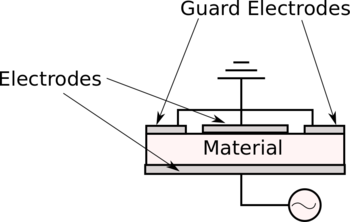Difference between revisions of "Permittivity and Permeability of Materials Obstacle Course"
(→Activities) |
(→Activities) |
||
| Line 23: | Line 23: | ||
# Read the first three sections of [[Media:Measuring_the_Permittivity_and_Permeability_of_Lossy_Materials_-_Solids,_Liquids,_Metals,_Building_Materials_and_Negative-Index_Materials_.pdf |this paper]] (pages 1-27). Pay particular attention to the permittivity (<math>\epsilon</math>) / capacitance and permeability (<math>\mu</math>) / inductance associations. | # Read the first three sections of [[Media:Measuring_the_Permittivity_and_Permeability_of_Lossy_Materials_-_Solids,_Liquids,_Metals,_Building_Materials_and_Negative-Index_Materials_.pdf |this paper]] (pages 1-27). Pay particular attention to the permittivity (<math>\epsilon</math>) / capacitance and permeability (<math>\mu</math>) / inductance associations. | ||
| − | + | === Capacitance Techniques === | |
| − | === Permittivity of a ''Lossless'' Material From a Capacitance Measurement === | + | === * Permittivity of a ''Lossless'' Material From a Capacitance Measurement === |
[[File:Epsiloncap1.png |right |350px]] | [[File:Epsiloncap1.png |right |350px]] | ||
| Line 36: | Line 36: | ||
<math>\epsilon_r</math>(glass): 3.7-10<br> | <math>\epsilon_r</math>(glass): 3.7-10<br> | ||
| − | === A Better Permittivity-Capacitance Measurement of a ''Lossless'' Material === | + | === * A Better Permittivity-Capacitance Measurement of a ''Lossless'' Material === |
[[File:Epsiloncap2.png |right |350px]] | [[File:Epsiloncap2.png |right |350px]] | ||
| Line 47: | Line 47: | ||
<br><br><br><br><br><br><br><br><br><br> | <br><br><br><br><br><br><br><br><br><br> | ||
| − | === Permittivity of a ''Lossy'' Material From a Capacitance Measurement === | + | === * Permittivity of a ''Lossy'' Material From a Capacitance Measurement === |
# Employ the guarded-electrode setup above and measure the lossy material's capacitance and conductance. <math>C=\epsilon^'\frac{A}{d}</math> and <math>G=\omega \epsilon^{''} \frac{A}{d}</math>, where <math>\epsilon^'\text{/}</math><math>\epsilon^{''}</math> are, respectively, the real and imaginary parts of the complex permittivity. | # Employ the guarded-electrode setup above and measure the lossy material's capacitance and conductance. <math>C=\epsilon^'\frac{A}{d}</math> and <math>G=\omega \epsilon^{''} \frac{A}{d}</math>, where <math>\epsilon^'\text{/}</math><math>\epsilon^{''}</math> are, respectively, the real and imaginary parts of the complex permittivity. | ||
Revision as of 10:11, 18 May 2018
PAGE UNDER CONSTRUCTION
Permanent Materials
- 6061 3/8" Al rod stock
- Teflon
- Glass microscope slide
- HP Signal Generator (DC-1 GHz)
- Oscilloscope (at least 1GHz bandwidth)
- Miscellaneous electrical components
Materials to Borrow When Necessary
- Milling machine
- Lathe
Activities
Reading
- Read the Wikipedia articles on permittivity and permeability. With the help of the instructor or TA try to achieve a physical understanding of just what the permittivity and permeability mean in a bulk material.
- Read the first three sections of this paper (pages 1-27). Pay particular attention to the permittivity () / capacitance and permeability () / inductance associations.
Capacitance Techniques
* Permittivity of a Lossless Material From a Capacitance Measurement
- Place three samples (air, Teflon, glass) between the aligned and polished ends of two 3/8" diameter, 1/2" lengths of 6061 Al rods (as shown at right). should be on the order of 1 mm. Measure the capacitances and, from the known surface area and spacing , determine the material's relative permittivity. (for a capacitor with no fringing fields).
- How do your measured permittivity values compare to standard reference values?
- Use this web applet to build a capacitor and observe the field lines . Are there fringing fields?
(air): 1.000536
(Teflon): 2.1
(glass): 3.7-10
* A Better Permittivity-Capacitance Measurement of a Lossless Material
- Use this web applet to build a guarded-electrode capacitor (as shown at the right) and observe the field lines . Are there fringing fields?
- Measure the three permittivities (air, Teflon, glass) again using this guarded-electrode setup.
- How do these results compare to your first (unguarded) measurements?
- How do these results compare to the standard values?
The measurements above for a lossless material amount to requiring the permittivity to be real (as opposed to complex). However, for a lossy material, the permittivity is complex and we need an additional characteristic (beyond simply the capacitance) to characterize the material. This additional characteristic is the conductance . The measurement below will include the conductance of the material.
* Permittivity of a Lossy Material From a Capacitance Measurement
- Employ the guarded-electrode setup above and measure the lossy material's capacitance and conductance. and , where are, respectively, the real and imaginary parts of the complex permittivity.












